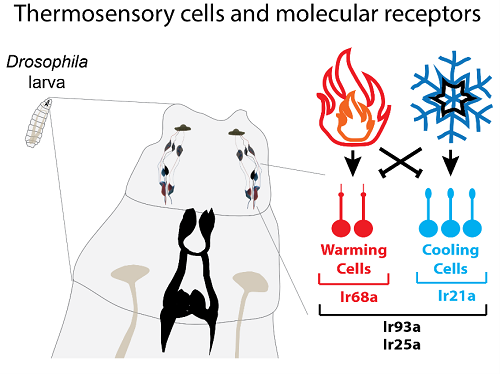
Warming Cells are activated by warming and inhibited by cooling, Cooling Cells vice versa. The receptor Ir68a, is needed to sense warming and the receptor Ir21, to sense cooling. The co-receptors, Ir93a and Ir25a, are needed for both cooling and warming sensing.
Cold blooded animals cannot generate significant internal heat and so depend primarily on their navigation skills to find regions with favorable temperatures. Some, like snakes, cave beetles, and young fruit flies (larvae), have evolved sensors that enable them to measure temperature changes as small as a few millidegrees Celsius per second, undetectable to humans and most mammals. The fruit fly (Drosophila melanogaster) larva also benefits from an ample genetic toolbox, and optical translucency (meaning scientists can see through it)—making it ideal for in-depth studies of thermosensation.
In our new study, we uncovered new molecular receptors, cells, circuits and behavioral strategies that underlie the exquisite thermosensitivity of fly larvae. One of the major roadblocks to understanding thermoregulation in the larva was that only their cooling-responsive cells (called Cooling Cells, or CCs) and their molecular receptors were known. Their warming sensing counterparts remained mysterious. We solved this problem with the discovery of new sensory neurons that mediate warming detection (Warming Cells, or WCs) as well as the combination of molecular receptors that work within these neurons to confer their warming sensitivity (Ir68a, Ir93a, Ir25a).
The discovery of these molecular receptors enabled us to use genetics to study how Warming and Cooling Cells determine the behavioral strategy fly larvae use to find and stay in regions with ideal temperatures. We found that CCs drive Cooling Avoidance behaviors while WCs inhibit them. Conversely, WCs drive Warming Avoidance behaviors while CCs inhibits them. At low temperatures (hypothermia), the CCs weight more in larvae’s behavioral decisions resulting in net Cooling Avoidance; at high temperatures (hyperthermia), the WCs weight more in larvae’s behavioral decisions resulting in net Warming Avoidance; at ideal temperatures (Euthermia) both weight the same resulting in the suppression of avoidance behaviors.

Behavioral strategy for thermoregulation. CCs drive Cooling Avoidance, and inhibit Warming Avoidance, WCs the opposite. In avoidance behavioral decisions, CCs weight more at low temperatures, WCs at high temperatures, and they weight the same at ideal temperatures. This interplay results in net Cooling Avoidance at low temperatures, net Warming Avoidance at high temperatures, and no avoidance at ideal temperatures.

Serial section electron microscopy revealed warming and cooling processing circuits with pathways that converge anatomically and physiologically (via the green neurons shown to the right). We found circuits that implement components of the behavioral strategy and also a circuit that integrates WC and CC pathways (green neurons below).
The behavioral strategy we found corresponds to a “Flexible Cross-Inhibition” between warming and cooling pathways. This strategy markedly differs from the widely held “labeled line” view (appealing in its simplicity, but inconsistent with our results), in which thermoregulation is achieved by two separate influences: cooling-activated receptors that drive cooling avoidance and warming-activated receptors that drive warming avoidance. Instead, we found that through opposing inhibition, both classes of thermosensors play important roles no matter whether the temperature is increasing or decreasing.
Last, we used electron microscopy to trace the downstream neural circuits of the WCs and CCs.Put together, our study shows that both Warming Cells and Cooling Cells are integrated to regulate responses to cooling and warming. The interplay of their pathways calculates avoidance responses according to how far larvae are from their ideal temperature (euthermia). In this way, larvae exposed to temperature challenges prevent hyperthermia (being too hot) and hypothermia (being too cold) and find their way back to euthermia.
This work is the result of the doctoral research Luis Hernandez-Nunez (2020 Ph.D.) conducted in the lab of Professor Aravinthan D. T. Samuel, in the Department of Physics at Harvard University. Luis is now a postdoctoral fellow in the lab of Professor Florian Engert, in the Department of Molecular and Cellular Biology.
Learn more in the original research article:
Synchronous and opponent thermosensors use flexible cross-inhibition to orchestrate thermal homeostasis. Hernandez-Nunez L, Chen A, Budelli G, Berck ME, Richter V, Rist A, Thum AS, Cardona A, Klein M, Garrity P, Samuel ADT. Sci Adv. 2021 Aug 27;7(35):eabg6707. doi: 10.1126/sciadv.abg6707. PMID: 34452914; PMCID: PMC8397275.
Additional References:
Molecular basis of infrared detection by snakes. Gracheva EO, Ingolia NT, Kelly YM, Cordero-Morales JF, Hollopeter G, Chesler AT, Sánchez EE, Perez JC, Weissman JS, Julius D. Nature. 2010 Apr 15;464(7291):1006-11. doi: 10.1038/nature08943. Epub 2010 Mar 14. PMID: 20228791; PMCID: PMC2855400.
Response of antennal cold receptors of the catopid beetles, Speophyes lucidulus Delar. and Cholera angustata Fab. to very slowly changing temperature. R. Loftus, G. Corbière-Tichané, J. Comp. Physiol. A 161, 399–405 (1987).
Sensory determinants of behavioral dynamics in Drosophila thermotaxis. Klein M, Afonso B, Vonner AJ, Hernandez-Nunez L, Berck M, Tabone CJ, Kane EA, Pieribone VA, Nitabach MN, Cardona A, Zlatic M, Sprecher SG, Gershow M, Garrity PA, Samuel AD. Proc Natl Acad Sci U S A. 2015 Jan 13;112(2):E220-9. doi: 10.1073/pnas.1416212112. Epub 2014 Dec 30. PMID: 25550513; PMCID: PMC4299240.
News Types: Community Stories
